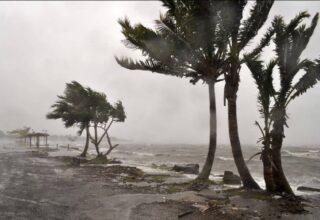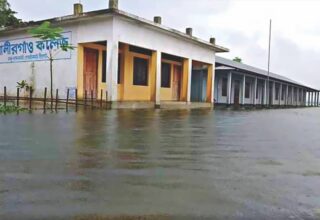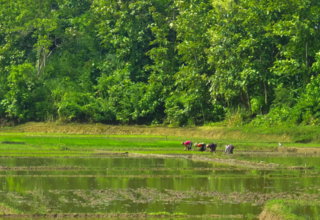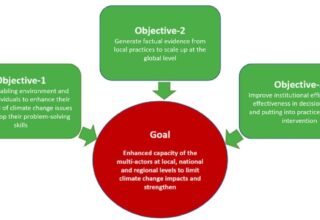
The IPCC AR6 report is a clarion call that if drastic steps to reduce emissions are not taken quickly we may cross the 1.5 Degree threshold within a decade or so
The sixth assessment report (AR6) of the United Nations Intergovernmental Panel on Climate Change (IPCC) recently released their Working Group 1 (WG1) report on science of climate change which made headlines around the world. Professor AKM Saiful Islam of BUET was one of its lead authors and has written about the scientific content of the report above. I will add some policy implications for the world, South Asia and Bangladesh to complement his article.
The first part of the report I want to highlight is that this is the first time that the authors of WG1 have used the word ‘unequivocally’ to say that human induced climate change impacts due to emissions of Greenhouse gases that is already happening around the world. This is a very significant warning which has been characterized as a ‘Red Alert’ to global leaders to take this issue much more seriously than they have in the past.
The second significant scientific advance is in what is known as ‘attribution’ science about extreme weather events such as heatwaves, wildfires, extreme rainfall, floods, hurricanes, cyclones, typhoons and droughts.
Until now the scientists who studied such extreme weather events took a lot of time after the event was over to provide an estimate of how much the event was enhanced due to human induced climate change. This was because the scientists had good computer models to say what would happen in the long term over fifty or a hundred years but not so good at predicting the short term or of saying whether or not a single event has been exacerbated due to the fact that global temperature had already enhanced over one Degree Centigrade due to human induced climate change.
This is a significant scientific breakthrough which has allowed the scientists to quickly attribute the recent heat dome effect in North America and wildfires in Greece and Turkey as well as the flash floods in Germany and China. It is important to note that these extreme weather events are not caused by human induced climate change but are very significantly made worse because we have already increased global mean temperature over one Degree Centigrade compared to pre-industrial period.
To cite an example from here in the Bay of Bengal, the cyclone Amphan which hit West Bengal and Bangladesh in May 2020 became a super cyclone while it was over the sea as the sea surface temperature, which provides the energy to the cyclone, was two Degrees above normal.
Thus going forward, it is likely that there will be more record breaking, and sometimes even record shattering, extreme weather events in different parts of the world every single day and things will get worse for at least another decade or more.
However, the worst that might happen beyond a decade or so can still be prevented if the emissions of Greenhouse gases are reduced very quickly to keep the global mean temperature below 1.5 Degrees Centigrade which all countries have agreed to do under the Paris Agreement adopted at the 21st Conference of Parties (COP21) of the United Nations Framework Convention on Climate Change (UNFCCC) back in 2015. The IPCC AR6 report is a clarion call that if drastic steps to reduce emissions are not taken quickly we may cross the 1.5 Degree threshold within a decade or so. Hence there is no more time to delay actions.
The policy implications of this important report at the global level is to reinforce the need for global leaders to treat this as a global emergency in which time is running out to switch from using all fossil fuels around the world and enhance the use of renewable energy such as solar and wind.
While this is indeed happening it needs to be accelerated very significantly and every country needs to take these actions by enhancing the Nationally Determined Contribution (NDC) that they made in 2015. This will be by far the most important outcome of the upcoming COP26 to be held in November 2021 in Glasgow, Scotland hosted by the Government of the United Kingdom.
The other actions that will be needed at the regional scale for South Asia as well as Bangladesh, and indeed other climate vulnerable countries and regions, is to become as well adapted to the upcoming climate change impacts as quickly as they can. The IPCC report has shown that every region of the of the world will suffer adverse impacts but some regions, such as South Asia, are highly vulnerable and hence we need to take actions urgently.
The good news is that countries in South Asia including Bangladesh have known about this for some time and have already started planning as well investing in building their adaptive capacity to tackle climate change impacts.
In this regard Bangladesh is recognised around the world as a leader in the field of adaptation with a focus on locally led adaptation and the recently established South Asia regional office of the Global Center on Adaptation (GCA) which is headquartered in the Netherlands has been set up in Dhaka.
This regional centre which is hosted by the Government of Bangladesh and is located in the new building of the Department of Environment (DOE) in Dhaka. It will be developing a strong program of cooperation across the countries in South Asia to share lessons and learn from each other on how to become more effective in adapting to the climate change impacts that will inevitably come.
The final impact of climate change that I will highlight from the IPCC report is the slow moving impact of sea level rise which will inevitably lead to salinity increase followed by inundation over decades in very low lying islands and mega deltas around the world.
As Bangladesh itself lies on one of these mega deltas this is of great concern for us and we need to develop plans for helping the communities in the low lying coastal zones to adapt now but be prepared to also help them move over time when needed.
In the global policy arena this issue of displacement of people due to sea level rise which will create climate refugees or climate migrants falls under the topic of Loss and Damage from human induced climate change and it is a hotly debated issue in the UNFCCC negotiations.
The publication of the IPCC’s AR6 report of WG1 has made the connection to human induced climate change impacts occurring already and hence in my view we can regard the 6th IPCC report as its 1st Report on Loss and Damage from Climate Change, even if it doesn’t use those words in the report itself.
Hence this issue will indeed be taken up by the vulnerable developing countries in the upcoming COP26 in November and as Prime Minister Sheikh Hasina is the current chair of the Climate Vulnerable Forum (CVF) she will be able to be the spokesperson on behalf of the vulnerable developing countries to ensure that this issue is indeed addressed adequately in COP26. Thus for the vulnerable developing countries the success or failure of COP26 will be determined by whether or not Loss and Damage is dealt with befittingly.
Originally this article was published on August 25, 2021 at Dhaka Tribune.
About The Author
Prof. Saleemul Huq is Director of the International Centre for Climate Change & Development (ICCCAD)









